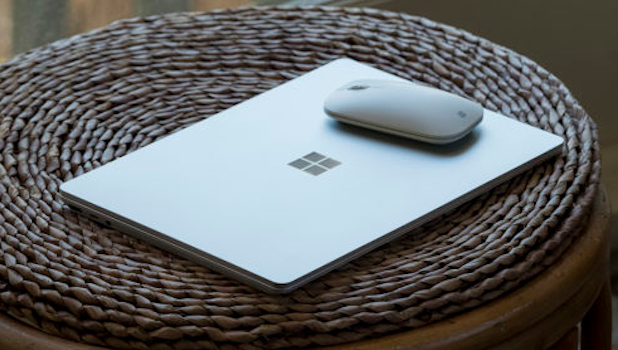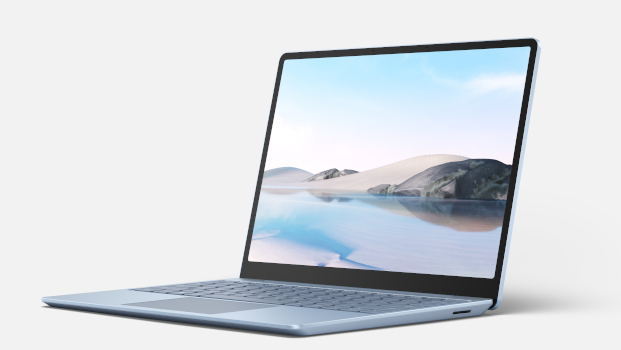
Microsoft debuts 12″ Surface Laptop Go
Microsoft’s new Surface Laptop Go finally looks like the Surface that everyone can buy. Announced Thursday, it’s a smaller 12.5″ notebook PC that retains the high points of the Surface lineup, at an accessible €649 price. Microsoft begins selling it 27 October with pre-orders open now.
Microsoft’s new Surface Laptop Go fits within the niche between the 10.5″ Surface Go 2 tablet, and the 13″ versions of the Surface Laptop 3. Inside lies a 10th-gen Core chip, though Microsoft has made some compromises, too: a return to Windows 10 S and a display that doesn’t quite reach 1080p resolution.
Surface Laptop Go: basic features
- Display: 12.45″ (1536×1024, 148 ppi) multitouch PixelSense display
- Processor: Core i5-1035G1
- Graphics: UHD Graphics
- Memory: 4Gb-8Gb LPDDR4x
- Storage: 64Gb eMMC, 128Gb-256Gb SSD
- Ports: USB-C, USB-A, Surface Connect, 3.5mm audio jack
- Camera: 720p f2.0 (user-facing)
- Battery: Up to 13 hours, Fast Charging
- Wireless: Wi-Fi 6 (802.11ax), Bluetooth 5.0
- Operating system: Windows 10 Home in S Mode
- Dimensions: 10.95×8.10×0.62″
- Weight: 2.45lbs
- Chassis: Aluminum
- Colours: Ice Blue, Sandstone, Platinum
Microsoft’s offering the Surface Laptop Go in three different colour schemes – the familiar Platinum and Sandstone, but also a new Ice Blue option.
While that €649 starting price is appealing, the basic Core i5/4Gb RAM/64Gb configuration should probably be passed over in favour of more powerful options. The €805.68 Core i5/8Gb RAM/128Gb SSD is acceptable, especially when paired with Microsoft’s OneDrive cloud storage. A 256Gb version tops the line at €1,002.43.
Across all configurations, Microsoft says you can expect the familiar Surface keyboard, Windows Hello accessibility and strong battery life, albeit with a few compromises here and there.

The first of these is a return to Windows 10 in S Mode, which debuted with the original Surface Laptop. Microsoft ditched Windows 10 S in later Laptops, however, suggesting that it had moved away from the OS. Windows 10 in S Mode prohibits traditional Win32 apps for security’s sake. However, Microsoft also makes it easy to for you to switch from Windows 10 in S Mode to Windows 10 Home, and for free.
The second is the Surface Laptop Go’s 12.45″ display. Though it incorporates the familiar 3:2 ratio found in other Surfaces, it doesn’t quite achieve 1080p resolution, at 1536×1024 (148ppi). To be fair, that’s about the pixels-per-inch (ppi) of a 15″ 1080p display, though buyers may not realise that.
Microsoft’s other Surface devices are known for having high-quality, 1080p cameras, but the Surface Laptop Go steps down to 720p – par for the course on many other rival laptops.
What we haven’t seen before on a Surface product is a fingerprint reader – other Surface products have used depth cameras for authentication. Microsoft has mounted it on top of the Surface Laptop Go’s power button. This approach has been effective for laptops from Huawei, such as its Matebook X Pro.
One interesting wrinkle is that the Core i5/4GB/64GB option does not include the fingerprint reader in the power button.
Surface Laptop Go design
The Surface Laptop Go design shows the give and take of creating an affordable laptop. Microsoft has returned to its metal finishes, apparently ditching the Alcantara fabric coating entirely. The smaller 12.4″ PixelSense display may feel cramped for intensive work, but it certainly helps shave off cost – and it might not be seen as a major limitation if customers are working in more cramped conditions at home anyway.
We might have hoped for an 11th-gen Tiger Lake chip inside the Surface Laptop Go, though Intel’s 10th-gen chips are certainly fine. It actually puts the Surface Laptop Go inside the same family as the Surface Laptop 3 (Ice Lake), at least where components are concerned.
The Surface Laptop Go’s port configuration appears very familiar, with a mix of USB-A and USB-C ports alongside the Surface Connector. You’ll probably want to add a USB-C hub to your shopping list if you’re thinking about an external monitor – and you might be, given the Surface Laptop Go’s smaller screen. Even the 10.5″ Surface Go 2 provided a 1920×1280 display. Intel’s 10th-gen processors support a 1080p external monitor, though, so adding one shouldn’t be an issue.

Microsoft says the Surface Laptop Go’s keyboard is equipped with a comfortable 1.3mm of key travel. Keyboards are a consistent strength for Microsoft’s Surface family, though earlier Surface Laptops included a more luxurious 1.5mm of key travel. (That tiny difference, believe it or not, is noticeable.) Underneath are Microsoft’s Omnisonic speakers. There’s also a pair of far-field mics for Microsoft Teams or Zoom calls.
A mystery that we’re waiting to examine: battery life. Microsoft claims the Surface Laptop Go will offer thirteen hours of battery life. Microsoft’s tests assume a rather dim 150 nits of light output, substantially less than what we use for testing. A nice plus is fast charging: Microsoft says you can charge your Surface Laptop Go to 80% in just over an hour.
Microsoft has flirted with a mass-market Surface before, but there have always been some tradeoffs. Microsoft’s first-generation Surface Laptop established the basics – a great display, keyboard and battery life – within a streamlined, minimalist design aimed at turning heads from Apple’s MacBooks on college campuses. But it also shipped with Windows 10 S inside, which may have turned off potential buyers. Microsoft’s Surface Laptop 2 was more of the same, while the powerful Surface Laptop 3 demanded a hefty €2,249 for the Intel Ice Lake option.
Meanwhile, Microsoft’s “affordable” Surface was its Surface Go lineup, a compact 10″ tablet that cost €469 with a Pentium-class processor.
The Surface Laptop Go fits somewhere in the middle. Will its performance follow suit?
IDG News Service








Subscribers 0
Fans 0
Followers 0
Followers